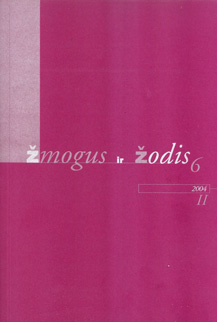Williamo Shakespeare’o atgarsiai Balio Sruogos dramose: tipologinis gretinimas
The Echo of William Shakespeare in Balys Sruoga’s Plays: A Typological Comparison
Author(s): Reda PabarčienėSubject(s): Literary Texts
Published by: Vytauto Didžiojo Universitetas
Keywords: Shakespearean (Elizabethan) tragedy; historical poetic drama; modern tragedy; epic world view; Romanticism; tragic conflict; hero.
Summary/Abstract: The article elucidates typological parallels between Sruoga’s and Shakespeare’s plays, it reveals similarities in problems, situations, characterization, logic of development, and world-view. The kinship between some characters is closer (Jogaila–Lear in the drama The Giant’s Shad), between the others it is more distant (Liucija–Ophelia in the drama The Giant’s Shade, Papagoda–Polonius in (Barbora Radvilaite), or it emerges as the object of conscious controversy (Jokubas Sobieskis–Hamlet in the drama Kazimieras Sapiega). Sometimes the kinship is more outward, repeating a general plot development, in other cases it is more inward, manifesting itself as a peculiar creative interpretation of a literary source. There are several different variants of Shakespeare’s individual (Lear in the dramas The Giant’s Shade, Kazimieras Sapiega, Romeo and Juliet in the dramas Radvila Perkunas, Barbora Radvilaite). On the other hand, Sruoga’s character may contain qualities of some of his / her predecessors (Elzbieta Oginskyte-Ophelia, Kordelia, Marija Seniauskaite-Ophelia, Lear in the drama Kazimieras Sapiega). Shakespeare’s motif’s can be traced only in those Sruoga’s works that deal with the historical epoch that is close to Shakespeare’s times, and in which the author aims at a more universal – philosophical and psychological – generalization. The investigation of Shakespeare’s impact on Sruoga’s plays is an attempt to identify classical tradition in them and to illuminate a tragic dimension. The parallels not only reveal typological similarities between the two authors but also show their differences, i. e. the peculiarities of Sruoga’s way of thinking and the Lithuanian concept of the tragic, as well as the new features accentuated by time and Lithuanian realia.
Journal: Žmogus ir žodis
- Issue Year: 06/2004
- Issue No: 2
- Page Range: 3-13
- Page Count: 11
- Language: Lithuanian

